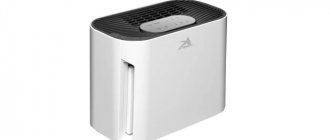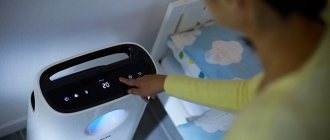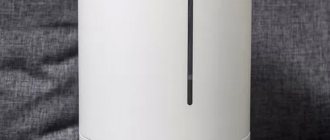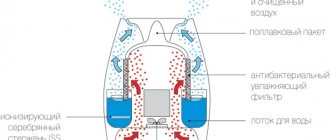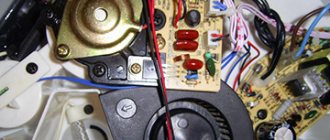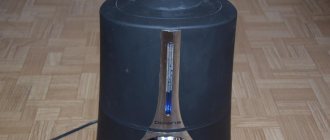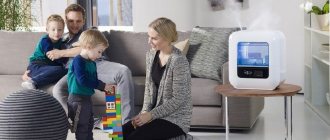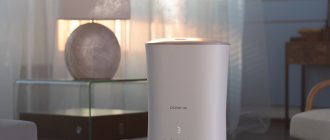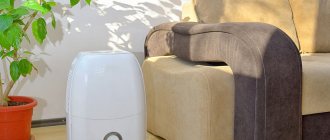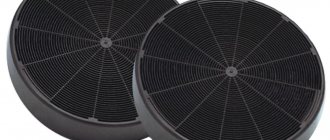The indoor air is saturated with harmful components that can cause many diseases in humans. In addition, in winter, the air in the room is dry, which also has a detrimental effect on the human body. Special equipment helps to cope with this task - humidifiers and air purifiers for enclosed spaces. Despite their small dimensions, these devices change the composition of the air to levels acceptable to the human body. Naturally, it is best to use these two devices at the same time, but if this is not possible, it is worth figuring out which is better: a humidifier or an air purifier in a particular case.
Device for purifying air masses
The purchase of budget Chinese air purifiers must be approached very carefully.
The main purpose of installing a purifier is to eliminate components from the air that are unsafe for humans. The purifier, passing air masses through itself, traps dust particles, hairs, sand, wool, mold spores, and waste products of mites. The main difference between the equipment is the installation of individual filtration. For a room where a large amount of dust accumulates, a cleaner with an electrostatic filter is suitable. In cases where it is necessary to remove an unpleasant odor, devices with a carbon filtration system are used. To completely break down solid particles, it is necessary to install a purifier with a photocatalytic filter, since other systems only capture and retain harmful components.
Washing humidifies and purifies the air
An air washer is also capable of humidifying air masses, but has additional functions. The device purifies the air simultaneously with humidification. Air masses constantly circulate through this device. All air in the room is cleaned by washing cartridges at least twice per hour. The air is filled with moisture naturally, which prevents waterlogging and maintains an optimal humidity level.
According to adherents of air washing, it is easier to breathe in the room where such a device is installed, there is no dampness and the unpleasant smell of stagnant air, which is often noticed in similar situations with humidifiers.
The air washer, which has a slightly different operating principle than a humidifier, is equipped with a built-in fan. The function of the fan is to ensure constant air recirculation. Thanks to it, the air is gradually humidified throughout the room. In addition, the fan disperses moisture throughout the space, creating a quick effect of air humidification. The sink also differs in that the air masses pick up as much moisture from it as they can absorb naturally.
The main principle of all sinks is that they “wash” the air of contaminants and dust, collecting dirt in a special tank with liquid. Or, after passing through the sink, dirt particles settle on the floor. The main disadvantage is that bacteria and fungi multiply well in the humid environment of the sink, so it requires regular cleaning. Constant cleaning is also needed around the sink, where small particles of dirt fall, as they can cause allergies or fungal diseases.
Humidifier or air purifier what to choose
Humidifiers are designed to create optimal humidity in an enclosed space. In accordance with GOST 30494-96, indoor humidity in cold weather should be no less than 40% and no more than 60%. When indoor air humidity is below 40%, a person becomes drowsy and chronically tired. When humidity levels drop below 30%, the human body is subject to stress. It rapidly loses natural moisture, which leads to a decrease in the immune system and, accordingly, to the occurrence of diseases.
Attention! According to statistics, in an apartment in winter, in which a humidifier is not installed, the humidity is only 25%.
Air purifiers are designed to trap particulate matter. Thanks to the installed filters, they are able to eliminate harmful components from air masses by more than 90%. Purifiers are typically installed more often in industrial environments where there are large amounts of particulate matter in the air.
Important! In order to understand whether it is necessary to adjust the humidity in the room or whether it is enough to just eliminate heavy air, you should measure the indicators using a hygrometer. It will accurately show the humidity levels in the room.
How humidifiers work
All humidifiers are divided into three types:
- Traditional humidifier. Air humidification occurs when air masses pass through replaceable filters. At the same time, the air is minimally cleaned of dust, but only from the largest fractions. The downside of the device is that it makes a lot of noise during operation, making it difficult to sleep at night.
- Steam humidifier. The water in the device boils and turns into steam, which humidifies the air. The device is convenient, but has numerous disadvantages. Noisy and not entirely safe due to the hot steam, it also consumes a lot of energy. It leaves behind condensation, which negatively affects wood and plaster.
- Ultrasonic humidifier. It is the most modern device for humidifying space. The membrane, which turns water into steam, operates almost silently. A special adjustment function allows you to control air humidification, which has a better effect on the process of saturating air masses with moisture. But these devices require careful care and constant diagnostics.
We recommend that you read: Choosing an air cleaner for an apartment or house
Humidifier + purifier: universal devices
An integrated approach to improving the microclimate: a 2in1 device
It is impossible to compare these two devices in terms of efficiency, since they perform completely different functions: a purifier eliminates heavy particles harmful to the body, and a humidifier maintains an optimal level of humidity in the room for excellent well-being. The most appropriate equipment option for individual use is 2in1 climate complexes, with the help of which harmful microparticles are eliminated and the required humidity is ensured. For example, the Smower Multi Action model. Such equipment is indispensable in rooms where there are children and allergy sufferers.
Functionality
Depending on the design of the humidifier, it is capable of:
- maintain normal humidity levels;
- clean the air from dust;
- remove electrical charges in the atmosphere of the room;
- device with a filter for humidification.
The purifier performs the following functions:
- cleanses from dust mites and their excrement - strong allergens;
- protects items from contamination;
- eliminates viruses, bacteria and odors;
- warms the room;
- removes excess moisture.
Multifunctional purifiers can dry damp air by collecting condensation. Devices with an ionizer saturate the air with oxygen ions, making it fresh and natural.
Humidifier with air purification function
Devices of this kind are a unique “combine” that combines two separate devices - a humidifier and an air purifier. Their feature is natural air humidification. The principle of their operation is to draw contaminated and dry air into the device using a built-in fan, where it is driven through special drums placed in water. Solid particles “stick” to the surface of the blades and are subsequently washed off into a special tray. And already purified and humidified air is supplied to the room.
Important! It is recommended to use a humidifier with an air purification function and the presence of a hydrostat, which controls the humidity in the room. This element will not allow excessive humidification of the air in the room.
Parameters to consider when choosing universal equipment:
- performance. For a room with an area of up to 20 m2, preference should be given to equipment with a capacity of 2 m3/min;
- size of the water tank. For a room of 40 m2, a 7 liter tank will be sufficient for high-quality humidification and cleansing;
- noise level, which should not exceed 40 dB;
- type of filtration system, installation of additional filters to eliminate unpleasant odors;
- additional functions such as shutdown when there is insufficient water, electronic control timer, ionizer.
Important! For finer purification of air masses and elimination of unpleasant odors, you will need a device that, in addition to the “hydrofiltration” system, is equipped with an additional filter. For example, the Philips HU4803 model affects air masses in 3 stages: trapping solid particles with a cartridge, removing bacteria and waste products from mites and viruses, and uniformly distributing air masses throughout the room.
Purpose
An air purifier physically cleans the air of harmful impurities:
- dust mites;
- wool;
- pile;
- smells;
- smoke;
- bacteria;
- fungal spores;
- plant pollen.
Only small molecules that penetrate through the filter can return to the room. With a water seal, everything is retained. The air comes out natural, clean and humidified.
A humidifier combats dry air by increasing humidity to an optimal level. Makes breathing easier, improves skin condition, partially removes dust from mites and reduces the number of bacteria. At the same time, it regulates the temperature in the room: hot steam heats the room, cold steam cools it.
Distinctive characteristics of the devices
Which is better: humidifiers or air washers? The comparative characteristics of the two types of equipment will help you understand this issue. When choosing a specific model, you need to read the reviews of the owners - this will protect you from inappropriate spending of the family budget.
Principle of operation
The peculiarity of the functioning of washing equipment is the natural circulation of air masses according to the principle of hydrofiltration. This is done by drawing dry air masses into the device body with a fan. As it passes through the disk system, it is flushed with liquid. After this, pure humidified oxygen enters the room.
Air washing device
To maintain a given level of moisture by the user, a constant spray mode operates. It is noteworthy that in the process the entire area is treated with water vapor or flavorings. Production occurs under the influence of electrodes immersed in liquid or due to the operation of a membrane with ultrasound.
The humidifier has a different design, where the essence of the work lies in the natural process of water evaporation. The device in appearance resembles a round tank, inside of which there is a sponge filter or cartridge immersed 50% in the liquid. The fan moves air masses through the filtration system and saturates them with moisture. As a result, the user receives oxygen without dirt and harmful impurities.
How a traditional humidifier works
Thus, the fundamental difference between the devices is that washing operates on the principle of moistening and cleaning. At the same time, dust, wool, and tobacco smell are eliminated. The humidifier only saturates the air flow with moisture, which is released outside in the form of steam or aerosol.
Please note: there are three types of humidifiers on the market: classic, steam and ultrasonic.
Steam Humidifier Ultrasonic Humidifier Traditional Humidifier
Functionality
Sinks are distinguished by uniform distribution of moisture in the room. Achieving this effect is due to the presence of a fan that constantly draws air from the room. The area is treated in 2-3 hours - after this time the user receives 100% pure oxygen without allergens and germs.
The sink distributes moisture evenly
Sink options:
- Three control options - mechanical switches, via touch display, using electronics. It is noteworthy that it is the latter type that is functional, since it is easy to repair and has a screen with displayed parameters. Although sensors are a tribute to fashion, they are impractical because they often break;
- The surface area to be treated depends on the specific model. Experts advise selecting devices with indicators higher than the living space where they are planned to be used;
- Water tank - the larger the container that is filled, the larger the dimensions of the unit, but at the same time the equipment operates longer without refueling. Ergonomic representatives are devices with a capacity of seven liters;
- Programs - setting through options allows users to set the “night” or “eco” mode. Such features reduce productivity and energy consumption;
- Possibility of using flavorings. A number of models are equipped with this option, where you can add aromatic products recommended by the manufacturer to a special compartment. However, people with sensitivity should use this feature with caution.
High-quality devices ensure economical water consumption and ensure uniform distribution of moisture. For example, if you use a humidifier, you get the impression that the air flow is not saturated, and the liquid evaporates.
This situation occurs because the devices cannot distribute steam evenly. To achieve this effect, you will need to leave the device in continuous operation for 14 days. Only during this period will moisture be absorbed from furniture and hard surfaces, which will negatively affect the service life.
But along with this, the humidifier solves other problems through the following functions:
- The presence of a stand for rotating the device and spraying steam at 360°;
- When the water volume is minimal, the light sensor is activated;
- Automatic shutdown if the liquid level is insufficient or the device falls;
- Ionization ensures purity of the output, however, it is not recommended to enable the option on a permanent basis;
The ionization option cannot be used continuously - Dirt sensors inside the equipment indicate the need to clean the filter and nozzle;
- Night mode with backlight and low noise switch off;
- Locking system if the device is assembled incorrectly. The same function works if the lid is not tightly closed;
- Possibility of aromatization. For this purpose, a special capsule is provided for adding oils;
- Illumination of the interior space.
Washings consume up to 20 liters of liquid per day, which, after processing, enters the surrounding space. The presence of a fan in the device is a positive characteristic, since during its operation the drops do not collect in one area, but form condensation. Moreover, there is no oversaturation of furniture, walls, floors and decorative items with moisture.
Note: the washes do not use electronic components, sensor boards or automation, but they are naturally saturated with moisture. The operation of the device is as close as possible to the natural circulation of air masses.
Thus, the user independently decides which devices - humidifiers or air washers - will perform the assigned tasks.
